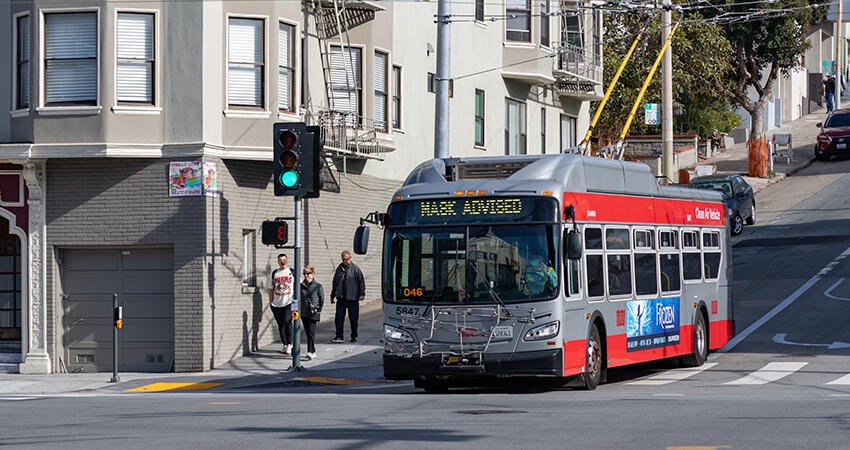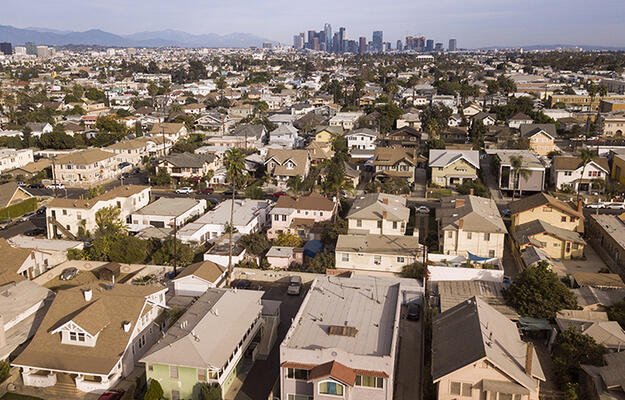
(brunocoelho/Shutterstock)
How Transit-Oriented Housing Can Advance Access to Opportunity While Curbing Climate Change
Access to public transportation connects people to work, health care, entertainment, and more. But not everyone has equal access.
Historically, low-income communities and communities of color have been cut off from public transportation. Across the country, highways and large infrastructure projects were often built in ways that furthered racial segregation and isolated people of color, including building on Native lands and running highways through and around Black communities. For those who’ve been disproportionately deprived of access, having quality, affordable public transportation near where they live can help improve their outcomes and narrow the opportunity gap.
Additionally, about half of all transport emissions come from light-duty vehicles, which hurt environmental and human health. When public transportation is more accessible and affordable, studies show that drivers are more likely to switch to buses and trains (PDF), which substantially cuts toxic emissions.
Thus, investing in quality transit-oriented development (TOD) and locating it in previously segregated areas could help connect people to much-needed services and advance access to equitable opportunities while reducing reliance on cars—helping to combat climate change.
How TOD could advance equity and reduce the effects of climate change
TOD is one approach to increasing the accessibility and reliability of public transportation. It enables or provides incentives for the colocation of services, businesses, and housing with transit to increase social and economic activity. It can include mixed-use development projects that incorporate housing, retail, and other amenities near the intersection of several transit options. These investments center housing and neighborhood amenities around transit hubs and often avoid increasing air pollution or traffic density significantly. They connect people to jobs, recreation, and each other, and they reduce reliance on cars.
Examples of successful transit-oriented development exist in urban, suburban, and rural areas. In Concord, Massachusetts, a town with just under 20,000 people, the local government intervened early on behalf of the community in redeveloping the town’s train station and surrounding area. Concord’s planning board negotiated for affordable units, fewer parking spaces to allow for a plot of green space, and pedestrian access to the train station. This project made Concord more accessible for commuters (PDF) and allows for residents of various incomes to live closer to a transit hub.
Arlington, Virginia, has been building transit-oriented development since the 1960s, before it was even a term. Over the past 50 years, Arlington invested in the Rosslyn-Ballston Corridor (PDF) to connect commuters across neighborhoods. The effort erected thousands of single-family residences and mixed-use developments, including retail stores, office space, and rental housing. Despite the semisuburban corridor having a high average income, fewer residents own cars relative to other demographically alike areas.
A metro line connects Arlington residents to Washington, DC’s urban center, considered one of the more walkable downtowns in the country. DC is known for its dense real estate, thousands of mixed-income apartments, and interconnected metro system, which is also more affordable than its peers. Compared with other large metropolitan areas, DC ranks fourth in share of public transportation commuters.
There is evidence of TOD exacerbating inequities, as its attractive amenities easily lead to higher rents and costs of living for those who live near it. When development plans don’t protect existing residents, especially those with lower incomes, those folks can be pushed out further. TOD developers and policymakers should ensure they don’t displace residents with low incomes or residents of color in their pursuit of TOD.
How local policymakers can encourage equitable TOD and combat the effects of climate change
Localities across the country often face barriers when trying to implement TOD, including restricted zoning laws that skew toward single-family residential development and directing costly investments toward projects that focus on more affluent, more white areas. Though numerous barriers exist to creating transit-oriented housing, local governments can consider several strategies to access its benefits.
- Allow for mixed-use developments near existing bus stops and transit hubs. Many zoning laws only allow for buildings to have one use, like single-family housing or retail. By raising building heights and expanding land uses, developers can help increase density and ridership in nearby stations and bring folks closer to transit to limit car use. Paired with incentives for affordable housing, local leaders can bring those with lower incomes closer to urban centers, rather than pushing them away.
- Reduce parking minimums for new developments. This can reduce asphalt, leading to lower surface temperatures and perhaps disincentivizing car dependency. It can also free space for housing units or green space. To increase ridership, transit agencies can consider expanding access to public transportation by adding stops along sparse lines, building more bus and train shelters, and adding bus lanes to potentially lower travel times.
- Use existing federal dollars to fund projects. Local policymakers can draw on federal supports for these multistep, multistakeholder TOD projects. The Federal Transit Administration offers grants for transportation planning and capital investments that can help local governments address both public transit and housing needs in their development plans. The Biden administration has invested billions in improving public transit and climate-friendly infrastructure to support local governments in this work. For instance, the plan included $213 billion to produce and preserve affordable housing units in traditional homes and commercial buildings while working to eliminate exclusionary zoning laws. The administration also hopes to invest $85 billion to modernize existing transit systems.
- Include residents from the start. Involving residents in the design process, understanding the affordability implications of development in a neighborhood, and advocating for the needs of long-time, lower-income residents to developers and other stakeholders are important to avoid displacement and to champion community interests.
- Establish community-benefit agreements. When projects are meant to protect communities from issues like gentrification, these agreements can promote benefits for existing residents, like rent control or good-paying jobs.
When done thoughtfully, TOD could reduce inequities by connecting nearby residents to services that advance access to opportunities. And by collocating these services where residents who most need them live, policymakers can reduce reliance on private transportation, reducing the effects of climate change.


